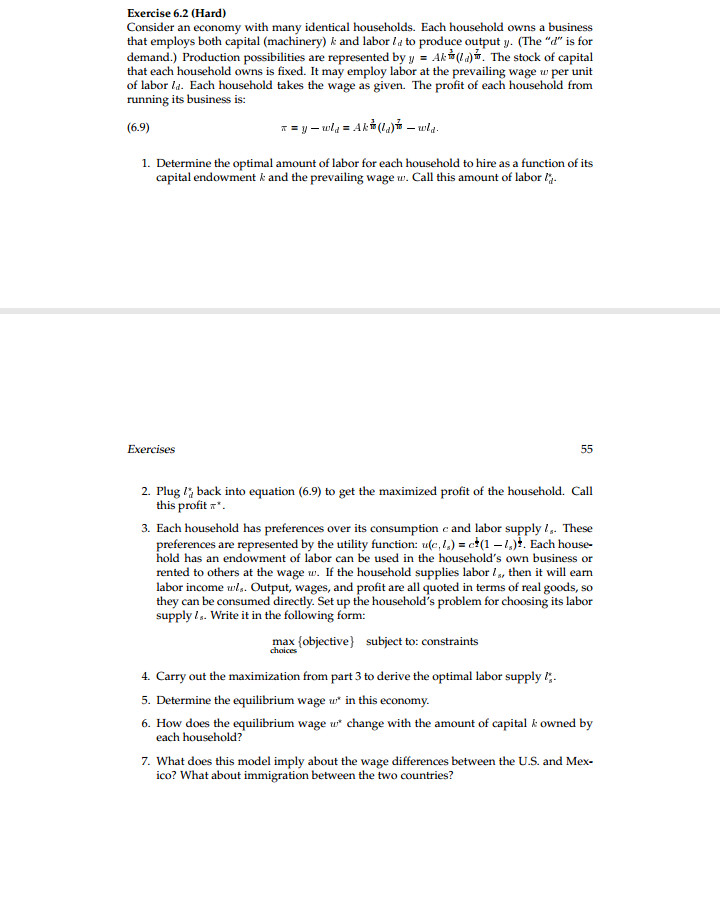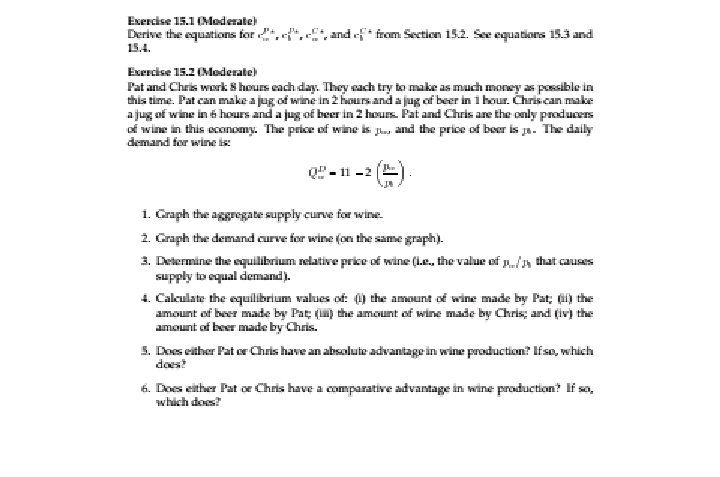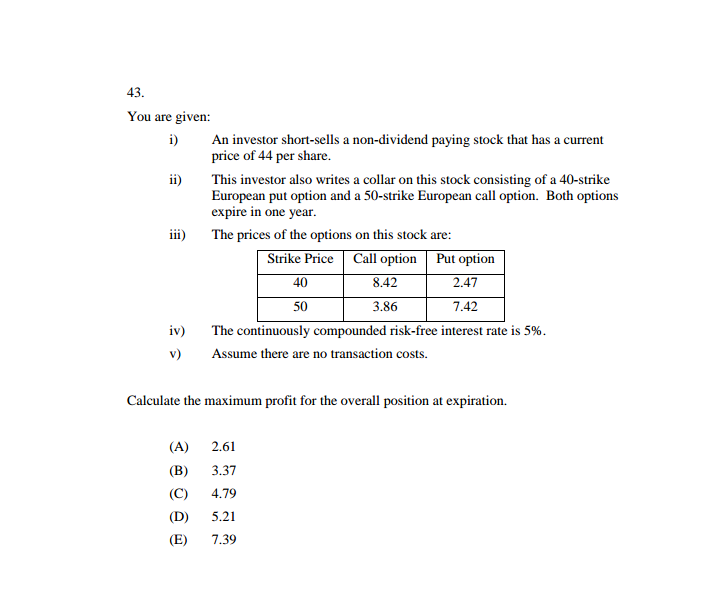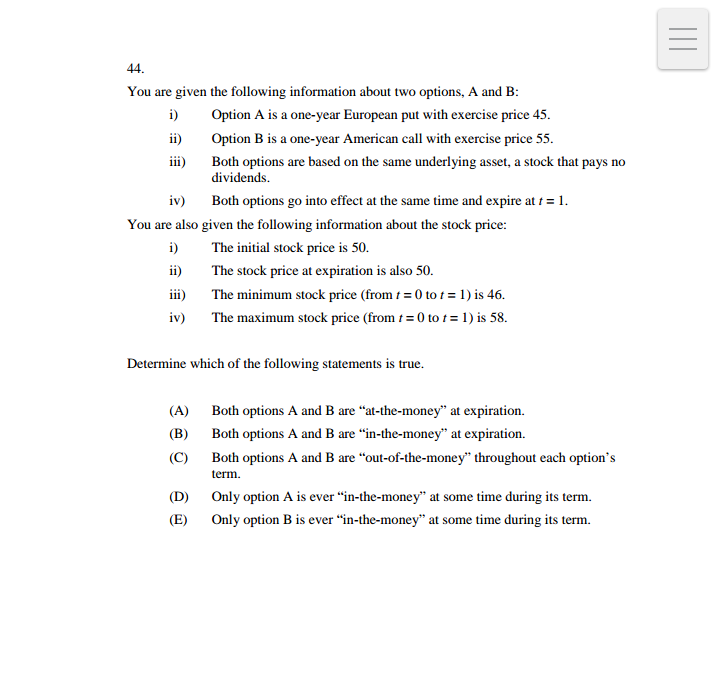




Answer showing all the workings
Exercise 6.2 (Hard) Consider an economy with many identical households. Each household owns a business that employs both capital (machinery) & and labor / , to produce output y. (The "d" is for demand.) Production possibilities are represented by y = Ak"(/,) ". The stock of capital that each household owns is fixed. It may employ labor at the prevailing wage w per unit of labor Za. Each household takes the wage as given. The profit of each household from running its business is: (6.9) T=y- wa= Ak(la)" - wid. 1. Determine the optimal amount of labor for each household to hire as a function of its capital endowment & and the prevailing wage w. Call this amount of labor ? Exercises 55 2. Plug /; back into equation (6.9) to get the maximized profit of the household. Call this profit ,*. 3. Each household has preferences over its consumption c and labor supply . These preferences are represented by the utility function: u(c, () = e?(1 -1,)?. Each house- hold has an endowment of labor can be used in the household's own business or rented to others at the wage w. If the household supplies labor /,, then it will earn labor income wis. Output, wages, and profit are all quoted in terms of real goods, so they can be consumed directly. Set up the household's problem for choosing its labor supply /s. Write it in the following form: max {objective} subject to: constraints choices 4. Carry out the maximization from part 3 to derive the optimal labor supply (- 5. Determine the equilibrium wage w* in this economy. 6. How does the equilibrium wage w change with the amount of capital & owned by each household? 7. What does this model imply about the wage differences between the U.S. and Mex- ico? What about immigration between the two countries?Exercise 13.5 (Hard) Tammy lives for two periods. In the first period of life she works / hours at a wage of w per hour. In the second period of life she is retired and supplies no labor. There is a perfect bond market on which Tammy saves an amount b in the first period of life, which earns a net interest rate of r = 0 (for a gross interest rate 1 + r = 1), so Tammy's savings pay off (1 + r)b = b in the second period of life. Tammy has preferences over consumption sequences {c1, c2) and effort ( as follows: "(( c,),() = va+ ve-e. The government taxes Tammy at a rate n on income earned in the first period of life, we. Tammy owes no tax in the second period of life. 1. Write down Tammy's budget constraint in each period of her life, substitute out the savings term b and show that Tammy's present-value budget constraint is: 2. Calculate Tammy's optimal choices of consumption, work, and savings: c, cz, f, and b, as a function of the tax rate n- 3. How much revenue does the government raise as a function of the tax rate n, T(). Find r, the tax rate at which government revenue is maximized. What is the maxi- mum amount of revenue the government can raise (that is, what is 71())? 4. Is there a Laffer curve? Exercise 13.6 (Hard) Use the same preferences and technology as in Exercise (13.5) above, except that here we call the government tax rate 12 instead of n. The government will allow Tammy to exempt her savings b from taxes (as in a 401(k) plan), so she owes tax at a rate ry in the first period only on the portion of her income that she does not save, w/ - b. Tammy still owes no tax in the second period of life. If Tammy saves an amount b she consumes (1 - 72)(wf - b) in period 1 and b in period 2. 1. Write down Tammy's present-value budget constraint. How is it different from the one you calculated in part (1) of Exercise (13.5) above? 2. Solve Tammy's optimization problem. What are her optimal choices of consumption, work, and savings ci, c2, f, and b as a function of the tax rate ry? 152 The Effect of Taxation 3. Now how much revenue does the government raise as a function of the tax rate r2 (call the revenue function 72(12)? What is the maximum amount of revenue the gov- ernment can raise? 4. Is there a Laffer curve? 5. How do your answers differ from those in Exercise (13.5)? Why?Exercise 15.1 (Moderate) Derive the equations force, ".c', and of * from Section 152. See equations 15.3 and 15.4. Exercise 15.2 (Moderate) Pat and Chris work 8 hours each day. They each try to make as much money as possible in this time. Pat can make a jug of wine in 2 hours and a jug of beer in 1 hour. Chrisican make a jug of wine in 6 hours and a jug of beer in 2 hours. Pat and Chris are the only producers of wine in this economy. The price of wine is po., and the price of beer is je. The daily demand for wine is: Oh - 11 -2 The 1. Graph the aggregate supply curve for wine. 2. Graph the demand curve for wine (on the same graph). 3. Determine the equilibrium relative price of wine (Le., the value of p /p that causes supply to equal demand ). 4. Calculate the equilibrium values of () the amount of wine made by Pat, (il) the amount of beer made by Pat; (i) the amount of wine made by Chris; and (lv) the amount of beer made by Chris. 5. Does either Pat or Chris have an absolute advantage in wine production?' Ifso, which 6. Does either Pat or Chris have a comparative advantage in wine production? If so, which does!43. You are given: i) An investor short-sells a non-dividend paying stock that has a current price of 44 per share. ii) This investor also writes a collar on this stock consisting of a 40-strike European put option and a 50-strike European call option. Both options expire in one year. iii) The prices of the options on this stock are: Strike Price Call option Put option 40 8.42 2.47 50 3.86 7.42 iv) The continuously compounded risk-free interest rate is 5%. V ) Assume there are no transaction costs. Calculate the maximum profit for the overall position at expiration. (A) 2.61 (B) 3.37 (C) 4.79 (D) 5.21 (E) 7.3944. You are given the following information about two options, A and B: i) Option A is a one-year European put with exercise price 45. ii) Option B is a one-year American call with exercise price 55. iii) Both options are based on the same underlying asset, a stock that pays no dividends. iv) Both options go into effect at the same time and expire at f = 1. You are also given the following information about the stock price: i) The initial stock price is 50. ii ) The stock price at expiration is also 50. iii) The minimum stock price (from / = 0 to f = 1) is 46. iv) The maximum stock price (from f = 0 to f = 1) is 58. Determine which of the following statements is true. (A) Both options A and B are "at-the-money" at expiration. (B) Both options A and B are "in-the-money" at expiration. (C) Both options A and B are "out-of-the-money" throughout each option's term. (D) Only option A is ever "in-the-money" at some time during its term. (E) Only option B is ever "in-the-money" at some time during its term
















